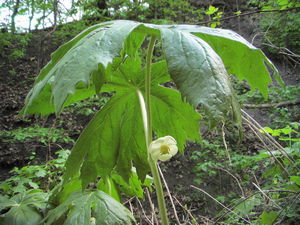Mayapples are a sweet, pungent fruit that grows wild throughout the Eastern United States. Because they are so abundant throughout the lands east of the Mississippi River, mayapples are among the most popular wild edibles, and hold a strong traditional place in native cuisine throughout the eastern half of the continent.
However, the popularity of the mayapple among foragers is variable, with some wild-edible chefs claiming that the once-popular fruit is actually acutely poisonous, and even potentially deadly. Claims about the fruit’s toxicity have been said by other foragers to be completely false or based in erroneous assumptions about the plant’s chemical composition.
Like all other members of the barberry family, the mayapple plant grows close to the ground and is herbaceous– green and leafy, lacking any wood. Its leaves are broad and umbrella-like, and its deep root is renowned among foraging herbalists for its ability to soothe sores, fight cancer, and treat viral infections topically.
The medicinal nature of the mayapple root comes from its content of podophyllotoxin, an alkaloid that is found, in a synthesized form, in many anti-cancer drugs. Topically, it is used to treat genital warts. However, as the name fo the alkaloid might suggest, podophyllotoxin is indeed a toxin, and, like any other medicine, it can be lethal in large– or even moderate– amounts.
Because of this, most proponents of cooking with wild edibles recommend against the use of mayapple roots in food, and encourage its medicinal use only with the careful supervision of a physician or qualified herbalist. The leaves of a mayapple, which also contain podophylloxin, are also a no-go for cooking.
However, this does not necessarily place the tasty, tangy mayapple fruit off-limits for adventurous foragers. The mayapple fruit was indeed a wild edible staple for hundreds of years before evidence of its potential toxicity ever made the headlines. Mature mayapple fruits are actually perfectly safe and almost completely free of toxins, but misconceptions and misunderstandings have led to both poisonings and excessively conservative foraging.
Despite its name, the mayapple actually matures in late summer or early autumn. Like most fruits, including popular choices like apples, pears, and tomatoes, the mayapple tastes foul and contains toxins like podophyllotoxin when it is consumed long before it ripens. It is possible that amateur foragers, basing their harvests on the plant’s name, have mistakenly eaten unripe fruits that contained these toxic compounds.
However, this unfortunate mistake need not prevent all fans of wild edibles from collecting mayapples to their heart’s content. Unripe potatoes and potato leaves are also poisonoius, but these facts does not prevent educated people from eating potatoes that have been responsibly harvested. Likewise, the tasty and pungent flavor of the mayapple need not be missed because of fears of toxicity.
To safely harvest mayapples with little-to-no risk of collecting poisonous fruits, be certain that you have definitively identified the correct plant. Harvest mayapples no sooner than August, and only when the fruits feel heavy and carry a strong, sweet smell. Ripe mayapples are soft and have an odor similar to muscadines and lemons. Taste the fruit to make sure it is ripe–one taste of even a very unripe fruit will not be a problem–before eating a large amount. If it seems excessively bitter, the wild fruits are not yet ready for harvest.
Like many wild edibles, mayapples can be dangerous if they are harvested irresponsibly or without proper education regarding the plant’s chemistry and biology. However, they also offer a wide variety of interesting and important culinary uses, and deserve a spot in the refrigerator of any wild-foraging chef. Educated harvest is the key to a safety and success in selecting wild edibles.
Source: Personal Experience; Moraes, R.M., H. Lata, E. Bedir, M. Maqbool, and K. Cushman. 2002. On American Mayapple as practical source of podophyllotoxin p. 527-532. In: J. Janick and A. Whipkey (eds.), Trends in new crops and new uses. ASHS Press, Alexandria, VA.


